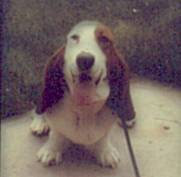
The coat is hard, smooth, and short, with sufficient density to be of use in all weather. The skin is loose and elastic. A Distinctly Long Coat Is a Disqualification.
WHAT TO LOOK FOR:
An all-weather coat, hard, short and smooth. It should be shiny and glowing with health, and it must be of a texture that can withstand damp and cold. Dogs who spend a great deal of time outdoors in winter weather often develop a dense, slightly wiry coat. This should not be confused with a long coat. The skin should be healthy and supple and elastic to the feel. You should be able to draw the skin from the body at any point, and not just about the neck where it is always loosest.
This loose and elastic skin will roll, rather than puncture, when the dog is in dense cover. However, it does not have to be excessive.
WHAT TO AVOID:
A Distinctly Long Coat which Must Be Disqualified. A long coat is soft, silky, and feathery like a Setter coat, with ear fringes and feathers on the legs and tail. The outer body coat is soft and silky, inclined to waviness. Soft and open coats should be faulted, as should tight skin with no elasticity.
COLOR:
Any recognized hound color is acceptable and distribution of color and markings is of no importance.
WHAT TO LOOK FOR:
Any hound color or variation of color is acceptable. A general statement is that "A good hound cannot be a bad color". It is all a matter of preference, because no officially approved colors are given with the ‘recognized hound color' definition. Blue pops up every now and then and although I have seen pictures of them, I have not seen an actual blue Basset in all my years in Bassets (since 1963). The blue color usually appears where the brown markings would be on a tri-colored dog. Needless to say, most breeders agree we do not like, and hope we never get, this color, but if one showed up in the show ring, you would have to judge it. The French say the red and whites are the oldest color combination, but the tri-colors are the most common.
Any markings are acceptable, including split faces. There is no such thing as a mis-mark in a Basset.
WHAT TO AVOID:
Letting the placement of
markings fool your eye. Sometimes the markings can be in such a manner
that the dog will look sway backed, or straight in shoulder, etc. Double
check.

This shows a split face. Although this marking is very
unattractive, it is nevertheless acceptable. However, this particular
bitch does not have a good
head